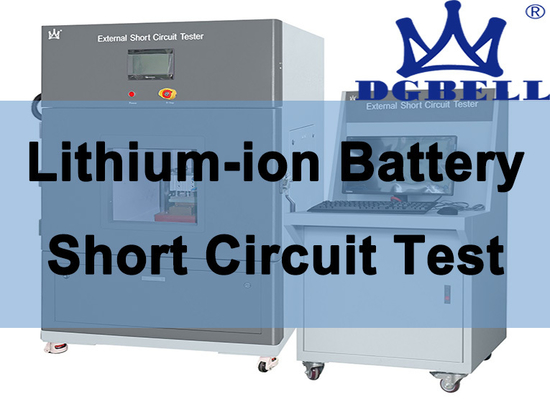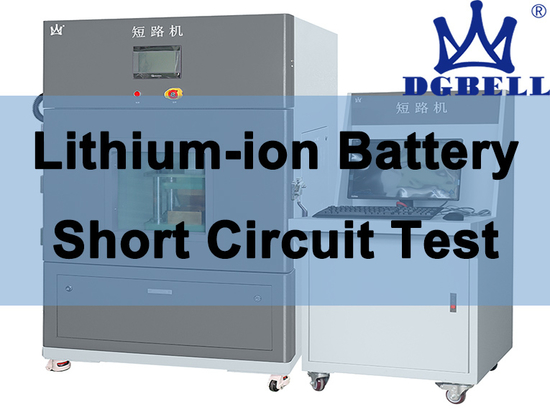
#Industry News
Safety Test of Lithium Ion Battery
Safety Test of Lithium Ion Battery
Lithium ion battery, and the whole sample composed of non user replaceable battery / lithium ion battery and its electronic products. For non user replaceable batteries, they shall be installed in electronic products as an overall sample for environmental safety test of lithium-ion batteries in the standard; For non user replaceable lithium-ion batteries, they can be placed in electronic products as a whole sample, or they can be taken out separately for the environmental safety test of lithium-ion batteries in the standard. It is recommended that they be preferentially selected as a whole sample for testing. As there may be air leakage, smoke, fire or even explosion during the test, necessary protective measures must be taken, such as placing the sample in a ventilation device with explosion-proof function.
Low pressure
Test purpose: the low-pressure test is used to simulate the impact of low-pressure conditions on the safety of lithium-ion battery during air transportation. After the test, the sample shall be free from fire, explosion and liquid leakage. Instruments and equipment: such as vacuum chamber (or low pressure test chamber), charge discharge tester, etc.
Temperature cycle
Test purpose: the temperature cycling test of lithium ion battery is used to simulate the safety of lithium ion battery when repeatedly exposed to low temperature and high temperature environment during transportation or storage. The test is carried out by using rapid and extreme temperature changes. After the test, the sample shall be free from fire, explosion and liquid leakage. Instruments and equipment: such as temperature test chamber, charge discharge tester, etc.
Vibration
Test purpose: this test simulates that the vibration during transportation and carrying shall not lead to safety problems such as liquid leakage, fire and explosion of lithium-ion battery. Instruments and equipment: such as vibration test bench, charge discharge tester, etc.
Precautions: the following points should be paid attention to in the vibration test of lithium ion battery: (1) the fixing method of the sample should not only ensure that the vibration signal is accurately transmitted to the sample, but also prevent the sample from deformation; (2) Each sample shall be subjected to vibration tests in different directions for many times; (3) As for the test direction, since the shape of lithium-ion battery may be irregular, it is necessary to test in three mutually perpendicular directions. In addition, it should be noted that a discharge charging cycle is required after the vibration test of lithium-ion battery. (it is recommended to use a special fixture during vibration to ensure that there is no change in G value caused by sample displacement during vibration).
Acceleration impact
Test purpose: the acceleration impact test of lithium-ion battery is to simulate the safety problems such as fire, explosion or liquid leakage after the acceleration impact encountered during the carrying or transportation of lithium-ion battery. Instruments and equipment: such as acceleration impact test bench, charge discharge tester, etc.
Precautions: the acceleration impact test of lithium-ion battery should pay attention to the following points:
(1) the acceleration impact test of lithium-ion battery is similar to the vibration test of lithium-ion battery. Attention should be paid to the fixing method of samples, multiple tests of each sample and test direction.
(2) The precautions for peak acceleration of acceleration impact test of lithium ion battery are the same as those of acceleration impact test of battery.
(3) In addition, it should be noted that a discharge charging cycle is required after the acceleration test of lithium-ion battery.
Fall
Drop the two end faces of cylindrical and button lithium-ion batteries once and the cylindrical surface twice, a total of four drop tests were carried out; Each side of the square lithium ion battery is dropped once, and a total of six tests are carried out; Drop test with equipment shall be conducted for non user replaceable battery / lithium ion battery, and the equipment shall be dropped once on each side. The sample shall be free from fire, explosion and liquid leakage.
Test purpose: this test simulates that accidental falls (such as falls from benches, desktop and hands) during transportation, carrying and use shall not lead to safety problems such as liquid leakage, fire and explosion of lithium-ion battery. This test simulates reasonable and predictable accidental falls, and does not consider the safety problems caused by man-made, intentional, unreasonable and unforeseen falls. Instruments and equipment: such as multi degree of freedom test bench, charge discharge tester, etc.
Precautions: the following points should be paid attention to in the drop test of lithium ion battery:
(1) each sample needs to withstand the drop test in different directions for many times;
(2) Necessary measures shall be taken to ensure the accuracy of the test direction, and the measures shall not affect the free fall movement;
(3) The accidental drop during actual use is also considered in the drop test conditions of lithium-ion batteries. Therefore, 1.5m drop test is required for some lithium-ion batteries; In addition, it should be noted that a discharge charging cycle is also required for the drop of lithium-ion battery.
Stress relief
The structure of the molded or injection molded thermoplastic shell shall ensure that any shrinkage or deformation of the shell material will not expose the internal parts when the shell material releases the internal stress caused by molding or injection molding. The sample shell shall not undergo physical deformation that will expose the internal composition.
Test purpose: stress relief test is to simulate the ability of lithium ion battery to maintain the integrity of the shell after withstanding appropriate high temperature. Instruments and equipment: such as high temperature test chamber, etc.
Precautions: the following points should be paid attention to in the stress relief test: (1) this test is only conducted for the lithium-ion battery with molded or injection molded thermoplastic shell; (2) Before the test, the test chamber shall be heated to 70 ℃± 2 ℃, and then the sample shall be put into the test chamber instead of the sample. After the test, the sample shall be taken out and restored to room temperature instead of being restored to room temperature in the test chamber; (3) If the sample is damaged by fire and explosion during the test, it is also judged as unqualified. (it is recommended to use clamps and other tools when taking samples to avoid scalding. At the same time, the tested samples should be placed in a special explosion-proof box for more than two hours.)
High temperature test
The sample shall have sufficient safety when used under high temperature conditions. Whether it is qualified shall be checked through the following high-temperature service test: place the fully charged sample in the high-temperature test chamber, and the temperature in the test chamber shall be set as the upper limit temperature of charge and discharge of lithium-ion battery, the upper limit temperature of charge and discharge of battery and the maximum value of 80 ℃. After the surface temperature of the sample is stable, it shall be maintained for 7h.
The sample shall meet one of the following requirements:
(1) cut off the circuit without fire, explosion and liquid leakage;
(2) Without cutting off the circuit, continue one discharge charging cycle according to the charging and discharging method during the high temperature test, and the sample shall be free from fire, explosion and liquid leakage.
Test purpose: this test simulates the safety of lithium ion battery in high temperature environment. For example, leave a mobile phone in standby or car charging state in a car exposed to the sun for a long time. Instruments and equipment: such as high temperature test chamber, charge discharge tester, etc.
Precautions: the following points should be paid attention to in the high-temperature test of lithium-ion battery:
(1) the high-temperature holding time of 7h is counted after the sample surface temperature is balanced. If the time for a discharge and charging cycle is greater than 7h, the high-temperature test time can be extended to the end of this charge and discharge cycle;
(2) The selection of test temperature is to select the upper charge temperature (e.g. 40 ℃) and upper discharge temperature (e.g. 55 ℃), upper charge temperature (e.g. 45 ℃) and upper discharge temperature of lithium-ion battery (such as the maximum value between 60 ℃ and 80 ℃. Generally, the upper charging temperature of lithium ion battery ≤ the upper charging temperature of battery < 80 ℃, and the upper discharge temperature of lithium ion battery ≤ the upper discharge temperature of battery < 80 ℃. Therefore, the test temperature is generally selected as 80 ℃.
(3) Since the air flow in the test chamber will accelerate the heat transfer, resulting in the loss of heat on the battery surface during charging and discharging, it may be necessary to reduce the wind speed and other methods to minimize the impact on the sample.
Conclusion
Lithium ion batteries are more and more used in communication, transportation, lighting and other fields. With their unique applicability and convenience, lithium ion batteries are more and more popular with the public. However, the safety of lithium ion batteries has been criticized by people and has been alerting us in safety tests. We should treat them seriously and realistically. The above are some humble opinions on safety tests for readers to discuss.







